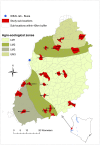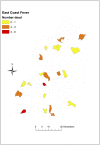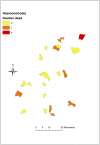Parasite co-infections and their impact on survival of indigenous cattle
- PMID: 24586220
- PMCID: PMC3930515
- DOI: 10.1371/journal.pone.0076324
Parasite co-infections and their impact on survival of indigenous cattle
Abstract
In natural populations, individuals may be infected with multiple distinct pathogens at a time. These pathogens may act independently or interact with each other and the host through various mechanisms, with resultant varying outcomes on host health and survival. To study effects of pathogens and their interactions on host survival, we followed 548 zebu cattle during their first year of life, determining their infection and clinical status every 5 weeks. Using a combination of clinical signs observed before death, laboratory diagnostic test results, gross-lesions on post-mortem examination, histo-pathology results and survival analysis statistical techniques, cause-specific aetiology for each death case were determined, and effect of co-infections in observed mortality patterns. East Coast fever (ECF) caused by protozoan parasite Theileria parva and haemonchosis were the most important diseases associated with calf mortality, together accounting for over half (52%) of all deaths due to infectious diseases. Co-infection with Trypanosoma species increased the hazard for ECF death by 6 times (1.4-25; 95% CI). In addition, the hazard for ECF death was increased in the presence of Strongyle eggs, and this was burden dependent. An increase by 1000 Strongyle eggs per gram of faeces count was associated with a 1.5 times (1.4-1.6; 95% CI) increase in the hazard for ECF mortality. Deaths due to haemonchosis were burden dependent, with a 70% increase in hazard for death for every increase in strongyle eggs per gram count of 1000. These findings have important implications for disease control strategies, suggesting a need to consider co-infections in epidemiological studies as opposed to single-pathogen focus, and benefits of an integrated approach to helminths and East Coast fever disease control.
Conflict of interest statement
Figures




Similar articles
-
Mortality in East African shorthorn zebu cattle under one year: predictors of infectious-disease mortality.BMC Vet Res. 2013 Sep 8;9:175. doi: 10.1186/1746-6148-9-175. BMC Vet Res. 2013. PMID: 24010500 Free PMC article.
-
Detection of carrier state and genetic diversity of Theileria parva in ECF-vaccinated and naturally exposed cattle in Tanzania.Vet Parasitol Reg Stud Reports. 2019 Aug;17:100312. doi: 10.1016/j.vprsr.2019.100312. Epub 2019 Jun 10. Vet Parasitol Reg Stud Reports. 2019. PMID: 31303233
-
Identification of a target population for immunisation against East Coast fever in coastal Kenya.Prev Vet Med. 2001 Nov 2;52(1):31-41. doi: 10.1016/s0167-5877(01)00236-7. Prev Vet Med. 2001. PMID: 11566376 Clinical Trial.
-
Epidemiology of East Coast fever (Theileria parva infection) in Kenya: past, present and the future.Parasit Vectors. 2012 Sep 7;5:194. doi: 10.1186/1756-3305-5-194. Parasit Vectors. 2012. PMID: 22958352 Free PMC article. Review.
-
Insights into Theileria transmission-blocking vaccines for East Coast fever control: A disease with an "outdated vaccination approach".Ticks Tick Borne Dis. 2024 Nov;15(6):102386. doi: 10.1016/j.ttbdis.2024.102386. Epub 2024 Aug 10. Ticks Tick Borne Dis. 2024. PMID: 39128161 Review.
Cited by
-
Nematode-coccidia parasite co-infections in African buffalo: Epidemiology and associations with host condition and pregnancy.Int J Parasitol Parasites Wildl. 2014 Jun 11;3(2):124-34. doi: 10.1016/j.ijppaw.2014.05.003. eCollection 2014 Aug. Int J Parasitol Parasites Wildl. 2014. PMID: 25161911 Free PMC article.
-
The prevalence and immune response to coinfection by avian haemosporidians in wild Eurasian blackbirds Turdus merula.Parasitology. 2024 Nov;151(13):1406-1415. doi: 10.1017/S0031182024000829. Parasitology. 2024. PMID: 39851095 Free PMC article.
-
The impact of invasive Sinanodonta woodiana (Bivalvia, Unionidae) and mussel macroparasites on the egg distribution of parasitic bitterling fish in host mussels.Sci Rep. 2025 Mar 19;15(1):9417. doi: 10.1038/s41598-025-93717-8. Sci Rep. 2025. PMID: 40108247 Free PMC article.
-
Pathogenicity and virulence of African trypanosomes: From laboratory models to clinically relevant hosts.Virulence. 2023 Dec;14(1):2150445. doi: 10.1080/21505594.2022.2150445. Virulence. 2023. PMID: 36419235 Free PMC article. Review.
-
More than Three Decades of Bm86: What We Know and Where to Go.Pathogens. 2023 Aug 22;12(9):1071. doi: 10.3390/pathogens12091071. Pathogens. 2023. PMID: 37764879 Free PMC article. Review.
References
-
- Petney TN, Andrews RH (1998) Multiparasite communities in animals and humans: frequency, structure and pathogenic significance. International Journal for Parasitology 28: 377–393. - PubMed
-
- Pedersen AB, Fenton A (2007) Emphasizing the ecology in parasite community ecology. Trends in Ecology & Evolution 22: 133–139. - PubMed
-
- Ezenwa VO, Jolles AE (2011) From host immunity to pathogen invasion: the effects of helminth coinfection on the dynamics of microparasites. Integrative and Comparative Biology 51: 540–551. - PubMed
Publication types
MeSH terms
Grants and funding
LinkOut - more resources
Full Text Sources
Other Literature Sources

